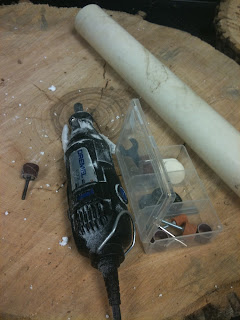Today has been a very busy day. We needed for all systems to be secured so we zip tied our PVC light structure to plant bed platform and zip tied the PVC that runs from the reservoir to fish tank. This PVC pipe has the actual 3/4 "pump plastic hose but we added a PVC pipe sleeve for structural support. We brainstormed several ways to make our ebb and flow. We first inserted a 6" X 3/4" PVC pipe, which we drilled random holes into for water to flow through, to plant bed bulk head and slipped a larger plastic sleeve cover to prevent clay pellets (Hydrocorn) from clogging PVC holes. This didn't work as hydrocorn were making their way under the plastic sleeve resulting in a clog. We searched around the building for a larger capped PVC pipe which could tightlly fit into sleeve and which we could zip tie in place. We were successful in doing this. The ebb and flow is tightly secured to sleeve and the added weight of cap has prevented hydrocorn from slipping underneath it. We were now ready to test system. After several minutes we noticed that the fish tank was filling at a faster rate than that of our reservoir. This is both good and bad. We didn't want our fish tank to fill at a faster rate than that of reservoir as the absence of water in reservoir will run down our pump. Ideally the entire system should have the same rate of flow. To correct the problem we added an elbow from plant bed bulk head, a control valve, and a longer PVC pipe to slow the rate. We also cut the larger plastic sleeve, that prevented hydrocorn from creeping through, to 1/2 it's size so that it influenced only the lower part of our PVC cap; in turn allowing a greater amount of water to creep into the ebb and flow but still keeping the hydrocorn out.
1 piece of our ebb and flow
hose/pvc clamped and zip tied to fish tank
manual control valve (will most likely be replaced with solenoid)
extended PVC
reservoir with pump
hydrocorn
tomatoes and such
pH dispensorSolenoid control valve
"The Beast"














No comments:
Post a Comment